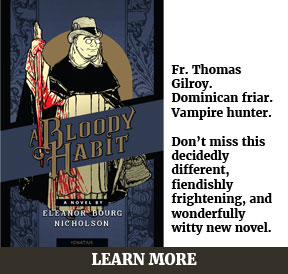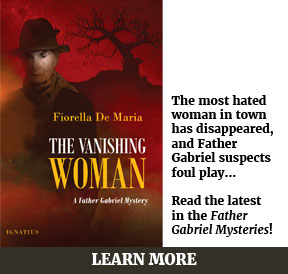The U.S. Post Office has just released a new stamp featuring Flannery O’Connor:

The description reads:
The 30th stamp in the Literary Arts series honors Flannery O’Connor (1925-1964), who crafted unsettling and darkly comic stories and novels about the potential for enlightenment and grace in what seem like the worst possible moments.
The color portrait on this stamp, a watercolor painting completed digitally, is based on a black-and-white photograph taken when O’Connor was a student at the Georgia State College for Women from 1942 to 1945. Surrounding O’Connor are peacock feathers, a symbol often associated with the author.
That’s all well and good, but the descriptive is decidedly hazy and unfocused—”the potential for enlightenment and grace in what seem like the worst possible moments”?—which is quite unlike O’Connor’s writing, which is marked by a vivid clarity that is often, yes, unsettling and decidedly, if not always overtly, Catholic.
But what of the image itself? Some reviews have been rather negative. “Wait,” writes Lawrence Downes in a June 4th New York Times op-ed, “what’s Betty Crocker doing on Flannery’s stamp?” And:
This stamp does not, to my eyes, show Flannery O’Connor, the 20th-century master of the short story, the “hermit novelist” who fused her art and life as a Southerner and a Roman Catholic with stories that are shocking, hilarious and often bloody. …
The United States Postal Service gave this job to an art director, who hired a freelance artist. I spoke with both of them, and learned that neither knew much about O’Connor, but they did their best with the images they had. The artist told me he had read one of her novels in college. He knew O’Connor had raised peacocks, so he framed her with feathers. The art director remembered that her work was “unsettling,” and that she was a Catholic.
I can’t blame either of them for deciding on this striking portrait as the best fit for their tiny canvas, but I wish they and the Postal Service had produced a stamp that was more recognizably the grown-up Flannery, and contained some taste of her strange and majestic artistic vision
I suppose we should be happy that O’Connor—one of the most distinctive and enduring authors of the 20th century—is getting publicity among a wider audience. I first read O’Connor while in Bible college, alongside works by C.S. Lewis, Charles Williams, T.S. Eliot, and Gerard Manley Hopkins. Eliot has long been a personal favorite since first reading his poetry in seventh grade, but O’Connor and Williams were revelations. A few years later, after entering the Catholic Church, I wrote the following essay about O’Connor, which focuses on the deeply Christocentric nature of her thought and art.
Flannery O’Connor and the Habit of Incarnational Art
Shocking. Grotesque. Surprising. Bizarre. Violent.
These and similar words have been used to describe the novels and short stories of a young Southern woman who lived quietly on a farm in Georgia with her mother and raised peacocks. Her short life––she died of lupus in 1964 at the age of thirty-nine––was ordinary in many ways, but her writings and thought were not. Flannery O’Connor was an extraordinary author and a Catholic artist of profound depth and insight.
Evidence for O’Connor’s uniqueness is found in how popular her work has become among people who know little or nothing about grace, the sacraments, and the Incarnation—realities that are central to stories filled with backwoods preachers, murderous ramblers, and tormented souls. “She was writing for an audience for whom the Incarnation had little meaning,” Jill Baumgaertner writes in Flannery O’Connor: A Proper Scaring, “and yet her fiction over and over again showed common people encountering the terror, mystery, and beauty of the Word made flesh.”
Well aware that many of her readers looked down upon the “mythical” idea that God became man and died, O’Connor made it the heart and soul of her work. In the preface to the novel Wise Blood she notes, “That belief in Christ is to some a matter of life and death has been a stumbling block for readers who would prefer to think of it as a matter of no great consequence,” Elsewhere she observes that the novelist must do what is necessary to shake readers from their slumber, to awaken them to the great and life-giving scandal of the Incarnation:
“The novelist with Christian concerns will find in modern life distortions which are repugnant to him, and his problem will be to make them appear as distortions to an audience which is used to seeing them as natural; and he may be forced to take ever more violent means to get his vision across to this hostile audience. When you can assume that your audience holds the same beliefs you do, you can relax a little and use more normal ways of talking to it; when you have to assume that it does not, then you have to make your vision apparent by shock––to the hard of hearing you shout, and for the blind you draw large and startling figures.”
Since first reading O’Connor’s stories in college many years ago, I’ve returned to them many times. But I’ve equally enjoyed her works of non-fiction: her collected letters, The Habit of Being, and her collected essays, Mystery and Manners. Both are filled with the crisp thinking, caustic wit, and deep sensitivity that characterized this Southern author. Both books are, I believe, essential reading for any Catholic who desires to write good fiction. O’Connor’s biting criticism and concrete wisdom are much-needed antidotes to the sappy prose, wooden dialogue, and paper-thin characters that characterize much “Christian fiction” today.
O’Connor reserved a strong dislike for those who “are interested in being a writer, not in writing.” Such people, she states, “are interested in seeing their names at the top of something printed, it matters not what. And they seem to feel that this can be accomplished by learning certain things about working habits and about markets and about what subjects are currently acceptable.” This is, she points out more than once, contrary to the nature of true art, which is a habit. In this belief she builds upon the teachings of one of her favorite writers, St. Thomas Aquinas, who “said that the artist is concerned with the good of that which is made . . .”
The Catholic who writes must not obsess over technique and style (as important as they can be), but must focus on the “concrete details of life that make actual the mystery of our position here on earth.” The artist must resist the temptation to become Manichaean, that desire to avoid the “mediation of matter.” Fiction, O’Connor insists, is “an incarnational art.” Art is both participation in the God’s creative work, but also a reflection in the new creation brought in to time and space by the Incarnation. O’Connor’s stories are suffused with the presence of the God-man: he haunts her characters, emerging in the wild and desperate acts of men and women facing their Maker in the shadows.
In response to an English professor who had written her a letter, O’Connor replied: “You said something about my stories dipping into life––as if this were commendable but a trifle unusual; from which I get the notion that you may dip largely into your head. This would be in line with the Protestant temper––approaching the spiritual directly instead of through matter.” The sacramental working of God through matter is not a device for O’Connor, but is the story. Reality is the drama of creatures of free will choosing between Christ and Satan, grace and damnation: “All human nature vigorously resists grace because grace changes us and the change is painful. . . . it is our dignity that we are allowed more or less to get on with those graces that come through faith and the sacraments and which work through our human nature. God has chosen to operate in this manner.”
The Catholic Church could use a few writers of fiction like Flannery O’Connor who embrace and work from the incarnational, sacramental worldview. To do so requires courage and a vision of reality that sees both the concrete and the mysterious with a clarity given by Christ, whose life and death and resurrection sheds light on every aspect of the human situation. “The Catholic writer, insofar as he has the mind of the Church,” O’Connor wrote, “will feel life from the standpoint of the central Christian mystery: that it has, for all its horror, been found by God to be worth dying for.”






Leave a Reply